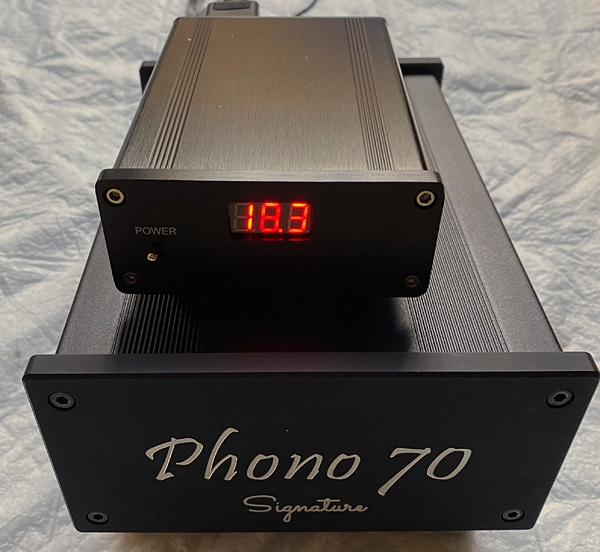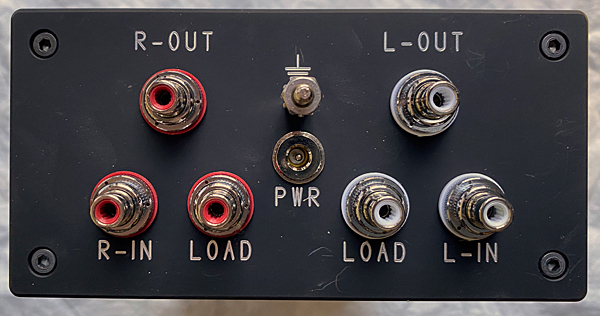| Columns Retired Columns & Blogs |
Too costly for buying on a whim, but right in there for when it will be time for real shopping.

The Paradox Phono 70 ($2500) and Phono 70 Signature ($3000) are identical except that the latter uses higher-quality parts. Both are designed exclusively for low-output moving coil cartridges and both offer 70dB of gain—not more or less. The company says the Phono 70 will work with 0.1mV MC cartridges. There's no gain flexibility because that would mean putting a switch in the signal path, and Paradox says "Switches degrade sound, period."
A compact, nondescript "damped rigid chassis" with "Phono 70 Signature" engraved into the front fascia in a nondescript typeface houses the Phono 70 Signature's circuitry. There's no attempt to hide the bolts holding the front plate to the chassis. It's all very basic, which is fine with me, especially since you're not going to be fiddling with it once you've settled on loading. It needn't be kept in view if you don't like the looks.
The back panel features high-quality, chassis-mounted RCA jacks for input and output and an additional pair for loading. No DIP switches need apply.

The Phono 70 Signature is completely hand-built. In addition to those upgraded parts, the Signature version is supplied with the company's "Pulse" AC power cord and a two-year "bumper to bumper" warranty (though of course the Phono 70 doesn't have bumpers. Come to think of it, neither do today's automobiles.)
Housed in a similar, modest chassis, the outboard 18V DC power supply uses wet silver-tantalum capacitors and 2W Audio Note silver-tantalum resistors. A large LED screen tells you the output voltage.
Inside the main chassis is "a specially engineered RIVER circuit board." The one-sheet language is ambiguous: "Special RIVER circuit board technology must be engineered for each product and is not a program." Robinson explained that everything on the circuit layout "flows like a river," with turns and corners "fattened to preserve flow especially in the ground/O plane."
Robinson, whose brother Ron designs the products, says the signal-path flow is unique and that all boards are gold-plated to eliminate corrosion. The copper is "extra thick," with "plate through" of all the holes, which aids soldering. The proprietary solder contains both gold and silver. Connected to that circuit board are matched, ultralow-noise LSK170 JFETs from Linear Systems and hybrid paper/Mylar dielectric-in-oil and "Difilm" coupling capacitors. Bypass caps are Duelund 0.01µF silver foil. The audibility of coupling caps is pretty well-established, so the company apparently wants you to know they paid attention in making this choice. The one resistor (per channel) in the signal path is the same 2W Audio Note silver tantalum type used in the power supply—which to be precise cost $57.48 each at partsconnection.com.
The details above are described by Paradox as "highlights of great importance"; the one-sheet concludes with three specifications said to be "of no sonic merit" and "subject to change": S/N ratio, >80dB; IMD, 0.001%; THD, <0.01%. In an email, Robinson explained: "We are not fans of specifications as people try to use them as opposed to their ears for purchasing decisions, and there is no type of electronic measurement more accurate than your ears for choosing audio."
I later learned from Robinson that the company has been around for many years; it showed a planar magnetic speaker at an early '80s Chicago CES. Its communications are a mess, though. The website is primitive, both the design and the writing. The Phono 70 Signature is hard to find, hidden behind "More" on the homepage.
Many mainstream audiophiles (and the audio companies that supply them) don't dwell on what's under the hood, but if you're going to put it out there, you need to do it well. If Paradox wants to move out of the shadows, where it apparently has existed for decades as a hobbyist-type company, into the light of the mainstream audio world, it needs to improve its website.
RIAA equalization is passive, using the aforementioned Audio Note 2W silver-tantalum resistors and matched precision parts for "highly accurate full range equalization to 50kHz." Does that imply that Paradox implements the de-emphasis of the so-called Neumann time constant of 3.18µs (50.05kHz)? "Yes," Robinson wrote in an email, in answer to a query, "but I do not wish to use engineer talk to describe what we are trying to achieving here. In its simplest form, we are keeping the roll off, which starts at 20kHz, from happening until after 50kHz." Read Keith Howard's discussion of this (some say spurious) addition to the standard curve that some phono preamp designers continue to use, though often it's switchable.
In a different email, Robinson wrote that he chose passive RIAA equalization over active equalization because active requires more parts in the signal path and everything is amplified, including noise produced by resistors and capacitors. With passive RIAA, he avers, the shunt to ground dramatically reduces noise, and there's only one resistor in the signal path. The only downside is a loss of 20dB of gain, and the Phono 70 Signature's 70dB gain is more than sufficient.
The unloaded input impedance is 100k ohms, so, to properly damp your moving coil cartridge, you need to load the input. Too much damping dulls and thickens the sound, while not enough leaves the high-frequency resonant peak free to work its sonic damage (although some people confuse that with air and detail). Because the load resistor goes from the input signal to ground, "there is no advantage whatsoever in using anything but precision metal film resistors," Paradox says. Using more exotic resistors—nude Vishays, for instance—will not produce an audible improvement. (I agree, although loading a step-up transformer is another story: There, resistor quality matters.)

Too costly for buying on a whim, but right in there for when it will be time for real shopping.

Hi
"Too Costly" ?
From my technical viewpoint, this $3,000 is a killing huge deal ! A rare example of unprofiteering business, consumers' wallent friendly, IMO.
I'm yet to find out which other makes phono-premp(s) in the marketplace today for much much much higher pricing offering quality designs as such:
(1) Costly Audio Note silver titanium resistors, silver foil caps.
(2) print-thru gold plated thick PC board
(3) PASSIVE RIAA EQ.
(4) class A amplication topology
(5 MC input.
"on a whim" ?
Sonics is a personal subject thing. With above such quality designs, $3,000 spending is NOT "a whim" at all, IMO.
Jack L

I said, "Too costly to buy on a whim."
Jesus Christ.
That meant that I could no simply buy one without consideration for cost.
I should have typed slower.
Did you miss..."but right in there for when it will be time for real shopping."
My hand is on my forehead regarding your reply.
Is that so hard to figure out?
You seem to get it at the end of your post, but taking "too costly" out of the sentence context is just silly.

Hi
OK. Write simple English next time then !
"but right in there for when it will be time for real shopping."
I would put it: "Here is the time for real shopping for a phono-preamp !"
Jack L

You internet trolls are amazing.

Hi
Not as "amazing" as your trolling misleading English, pal !
Jack L

I don't think the problem lies with him, pal.

Hi
Not many readers got the whole world's time to read it "several times".
I don't. Who doesn't want to read simple straight-forward Enlgish ?
Jack L

I hope you find your way out from under your troll bridge!

A Star Trek level paradox:
"Sorry for going overboard (about how big companies get reviews because they advertise), but the big magazines will not review my products unless I become an advertiser with them. I have been told this directly."
Is Stereophile not a big magazine? If not, who is?

... you should include MF's response as well: "but I didn't ask you to "pay to play," did I? Which is not to say that some other magazines don't work that way."

Hi
This statement sounds paradoxical, right ?
Mr. Robinson misused the key controversial word "the" instead of the proper word: SOME.
Take it easy, loyal Stereophile patrons !!
Jack L

..but just wanted to give an accolade to this site. You are, IMO, the best reviewer in the industry...always learn something and am always available to read any review you post. Something to be learned each time.

Thank you Mr. Fremer for such a great review.
Terence Robinson